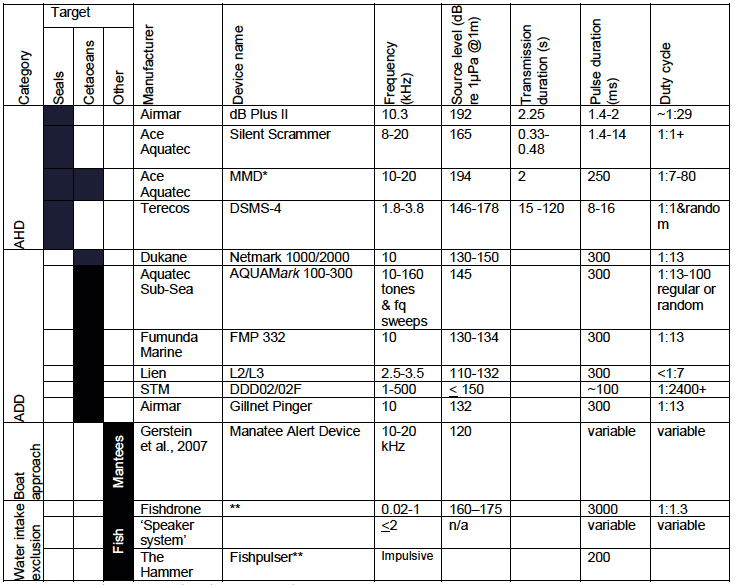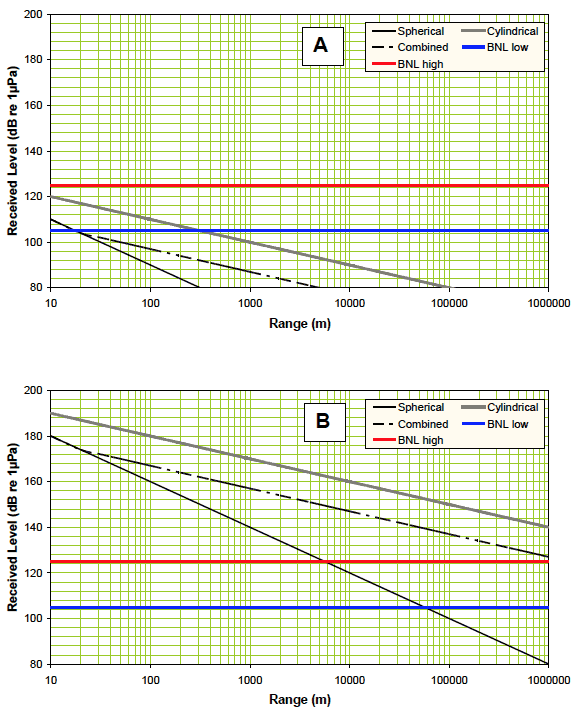The use of acoustic devices to warn marine mammals of tidal-stream energy devices
This report explores the potential need for acoustic deterrent devices at high energy sites to warn marine mammals to the presence of tidal devices.
Existing acoustic warning equipment
The bulk of marine mammal-human interactions that have involved the purposeful introduction of acoustic energy (e.g., ADDs/ AHDs) have been related to fisheries and aquaculture. As such, a variety of devices have been developed primarily to deter mammals from approaching and interacting with fishing gear or cages. Modern devices generally fall into two categories. Acoustic Harassment Devices ( AHDs, sometimes Commercial Aquaculture Acoustic Devices CADDs) which produce intense sounds (above 185 dB re 1 μPa) with the general intention of discouraging or excluding animals from proximity to a resource such as a fin-fish cage. Acoustic Deterrent Devices ( ADDs), on the other hand, produce less intense sounds (below 185 dB re 1 μPa) with the aim of reducing bycatch in fishing equipment. That these devices may work is well known (Fjalling et al. 2006; Kraus et al. 1997) but why they only sometimes work and how they work are more mysterious. The acoustic pulses, tones or sweeps that these devices produce are variable across the brands and versions but most emit synthesised sounds of entirely artificial origin without known biological significance (Gordon et al., 2007). AHDs (also known as 'seal scarers/scrammers') are thought to work primarily by emitting sound levels so powerful that they are painful or unpleasant for a listener at close range. ADDs (also known as 'pingers') operate at lower sound pressure levels (usually <150 dB re 1 μPa) and are therefore unlikely to cause discomfort. Instead it is thought that they promote more local avoidance behaviour (Cox et al., 2003). By presenting an unusual sound, pingers may also prompt animals to proceed with greater caution and therefore detect an actual threat (such as a fishing net) more readily. Though ADDs have been shown to reduce bycatch in a wide variety of fisheries (Reeves et al., 1996), they have also been found to increase depredation (prey removal) in others (Bordino et al., 2002). This is perhaps because animals, once alerted, can choose to do different things with the information. The so called 'dinner bell' effect is one such example, where animals (e.g. sea lions) appear to learn to associate the introduced sound with the presence of nets and prey-fish caught in them (Bordino et al., 2002). The use of potentially painful sounds used by AHDs are intended to counter the dinner bell effect by using unpleasant stimuli to discourage animals from actually getting close enough to cause damage to fish, cages or themselves.
A variety of AHDs and ADDs have been developed for application in a wide variety of fisheries or aquaculture applications. Though the precise characteristics of several of these remain in commercial confidence, key features of many were summarised by Gordon et al. 2007 and have been outlined in Table 2.
Table 2. Characteristics of selected acoustic warning devices. Adapted from Gordon et al. 2007; Lepper et al. 2004; McKinley et al. 1988; Ace Aquatec promotional material (AA-03-037) and Gerstein et al. 2007.

* Promotion includes tidal turbine acoustic warning
** Low-frequency mechanical sound generators
In contrast to the use of artificial sounds, several studies have investigated the use of biologically meaningful sounds, principally killer whale calls, for deterring marine mammals (Anderson and Hawkins 1978). Seals and cetaceans are particularly sensitive to killer whale vocalisations because they are one of their primary predators and their calls are likely to elicit responses over and above any specifics of absolute sound intensity or novelty. Trials to gauge how marine mammals (seals and small cetaceans) respond to playbacks of killer whale calls, have however returned mixed results ranging from strong avoidance (Fish and Vania 1971) and rapid flight (Anon 2002, as cited by Gordon et al., 2007) to transitory responses (Shaughnessy et al. 1981) and few response at all (Deecke et al. 2002). Perhaps it is unsurprising that use of such a biologically meaningful sound will elicit complex responses from animals hoping to evade a stealth predator. As pointed out by Gordon et al., (2007) it is also worth considering what impact frequent playbacks of killer whale calls might have on the local killer whales in an area.
Acoustic devices have also been used to reduce other (non-fishing related) human-marine vertebrate interactions. For example, a range of devices have been developed to discourage fish from approaching the cooling water intakes of power stations
With 25% of all documented Florida manatees fatalities and almost all living animals exhibiting scars from powerboat collisions (O'Shea et al., 2001; Calleson and Frohlich 2007), efforts at reduction have included studies of the boat-animal acoustic interactions (Gerstein et al., 2001). It appears that while manatees can hear fast moving powerboats and commence avoidance behaviour, they do not perceive the lower frequencies of slower moving boats (Gerstein et al., 2001). This shift in understanding from the assumption that fast moving boats were the problem has prompted a contentious re-think of speed restriction guidelines (Calleson and Frohlich 2007) and the testing of a narrow-beam, bow-mounted acoustic alarm for vessels operating at low speeds (Gerstein et al. 2001). A proposed alarm projects two ultrasonic source frequencies (230 and 250 kHz) that interfere with each other to produce a highly directional 20 kHz sound beam directly in front of the vessel. This emission was not intended to scare or harm manatees but instead to provide a consistent highly directional cue that manatees might learn to associate with boats (Gerstein 2002).
In contrast to a cue that animals might learn to avoid, whalers noticed that large whales showed spontaneous strong aversive responses when exposed to primitive sonar ( ASDIC emitting short pulses between 10 and 26 kHz). Originally intended to be used to track whales, operators on whaling ships found that their quarry seemed to be irritated or frightened by these signals and responded by bolting away in straight lines which then made them easier to harpoon (Gordon et al., 2007).
In addition to using sound to manipulate marine mammals, there have also been a suite of studies considering fish responses to sound, primarily to reduce their loss in large areas that cannot be easily screened such as power station water intakes and irrigation channels. In a review, McKinley et al. (1988) considered several devices and documented wide variations in the nature of fish responses to the low frequency devices on the market. Overall, they found that fish could be made to avoid water-intakes with sound but that no devices were completely effective. Instead they excluded considerably less than 100% with a maximum of 85% of individuals reacting to the most successful sonic device tested (McKinley et al. 1988; Anon, 2006). It is perhaps unsurprising (on account of different auditory abilities) that they observed wide variation between species, especially comparing pelagic and benthic ones, however they also saw markedly different responses in closely related species (e.g. sockeye versus Coho salmon). Furthermore some species, particularly predatory ones, were attracted to the noises while others were repulsed. Though fish did respond does not necessarily mean that these devices proved suitable for excluding fish from intakes. In some cases, for example, the fish required several minutes of exposure before they began to take action, furthermore, many of the frequencies tested didn't elicit turning with a relevant directionality to avoid the danger (McKinley et al. 1988). Overall, the use of low frequency transducer-based sound systems and those focussing on producing substantial particle motion, did not appear to be viable alternative for protecting fish at water intakes. However, high-frequency, transducer-based systems were effective in generating avoidance and exclusion for "hearing-specialist" species such as clupeids (shad and herring) and alewifes at intakes. High frequency systems have shown mixed and partial success with salmonid species (salmon and trout) guidance and exclusion ( EPRI 1999).
In addition to absolute exclusion, acoustic methods have also been used to steer fish movements so that they didn't approach a danger. For example, a prototype sonic barrier was installed and evaluated at the confluence of Georgiana Slough and the Sacramento River in the USA (Figure 11, Anon 2006). The barrier consisted of a series of acoustic devices positioned at a bend in the river's flow to encourage migrating Chinook salmon smolts to use the opposite side of the river and so transit the area without encountering the area of danger (Anon 2006). In addition to physical screens, ladders, louvres and sonic methods to move fish away from danger, a variety of other natural and artificial ideas have been tested including: 1) natural - ambient light, flow velocity, depth, channel shapes and temperature and 2) artificial - vertically hung chains, electromagnetic fields, strobe lights, bubble curtains, water jets and even chemicals. Of these methods the non-acoustic artificial ones have generally proved ineffective with little or no success (Anon 2006).

Figure 11. Acoustic barrier deployed to divert Chinook salmon from entering Georgiana Slough in California, USA. The sound system consisted of a 250 m long linear array of acoustic transducers suspended from buoys that were placed approximately 300 m upstream from the slough entrance and generated sounds at 300-400 Hz. The acoustic barrier angled out from the slough-side shore with the objective of deflecting the out-migrating fish to the far side of the river, away from the slough entrance (Anon 2006).
In this section, we have briefly described previous applications of acoustic devices intended to influence the movements of mysticetes, odontocetes, pinnipeds, sirenians and fish. Though there are a wide variety of stimuli and outcomes it is clear when looking across these studies that it is possible to use sound to influence marine vertebrate behaviour and movements in relation to potentially dangerous human activities. The majority of devices make somewhat arbitrary, artificial sounds at a range of amplitudes and also elicit a variety of responses. These responses range from fright and bolting ( ASDIC-whales), through to wide- and narrow-scale avoidance ( AHDs and ADDs, fish-alarms) and even attraction (pingers-sea lions, fish alarms-predatory fish). Some devices might result in learning with intended useful outcomes (boat alarms-manatees) while others result in deleterious consequences (pingers-sea lions). Though less studied, most could suffer some degree of habituation (Cox et al., 2001). However, probably the most striking result was that, despite wide-scale efforts to develop acoustic devices, there remains a very poor understanding of why these sounds work at all. Central to this question is what the animals perceive the sounds as, and for them, what an appropriate response would be. Synthesised killer whale calls offer the most obvious path to an intelligible response but the mode of operation of the pings, buzzes, clicks, beeps and whistles of other devices are unknown. Crucially, if the intention of a warning device is to prompt an animal to exhibit a specific behaviour with directional relevance (e.g. safely steer around a turbine) then some notion of what feature of a sound the animal is actually responding to is also required to ensure that the stimulus is optimised and appropriate.
Audibility of existing acoustic warning equipment in tidal-sites
The development of modern acoustic warning equipment has primarily been to either keep marine mammals out of fishing nets ( ADDs) or away from aquaculture interests ( AHDs). These sites are typically in open coastal or sheltered inshore waters which are not subject to the elevated natural noise levels of tidal-sites. To investigate what impact this alternative setting would have on the audibility range of these acoustic devices we compared the minimum and maximum ambient sound levels measured in the Sound of Islay (114-131 dB re 1 μPa) against the output intensity of these devices.
To compare sound levels with typical ADDs such as the Dukane Netmark 1000 pinger and its successors, we first referenced the Sound of Islay ambient noise to the specific frequency band used by most of these devices. They typically emit signals around 10 kHz (with less intense harmonics) so we filtered the recorded ambient sound down to a third octave around this fundamental frequency (Erbe 2011) using a Fast Fourier Transform filter (size 4096, hamming window). From this we derived upper and lower levels for an ambient noise third octave band (8.9 to 11.3 kHz) corresponding to an animal audition window within which the acoustic warning signal will sit. We used an ADD signal strength of 130 dB re 1μPa as a generic level (Table 2). AHDs, in contrast produce louder signals and are more variable in their frequency components (5-30 kHz) between both brands and models (Table 2). The responses of different taxa (particularly odontocetes and pinnipeds) towards this diversity of AHD devices are less well understood (other than the fact that they are much louder), so we considered the audibility of the better known ADD-like signal at a strength equivalent to the upper extent of marketed AHDs (200 dB re 1μPa, Table 2).
To assess how far these generic ADD and AHD signals might propagate in tidal sites we considered several variants of simplistic but standard transmission loss equations. Three types of geometric spreading were used: 1) Spherical spreading, where the energy from a sound source can propagate uniformly in all directions ( TL = 20log 10(R) with TL being transmission loss and R the range from the acoustic source); 2) Cylindrical spreading, which applies to shallow water and spreading occurs in two dimensions only ( TL = 10log 10(R)) and 3) Combined spreading loss; where near the source the sound propagated spherically then at some range (H) where the range is greater than the water depth (in the sound wave propagates cylindrically (TL = 20log 10(H) + 10log 10(R/H)). For simplicity we considered the sound to be a point source at turbine hub height and positioned slightly deeper than mid water column in a 50 m site to allow for surface vessel clearance (i.e. 22 m from the bottom).
To consider acoustic warning device propagation distances we combined the information on the upper and lower levels of ambient sound (1/3 rd Octave around 10 kHz from Sound of Islay) with generic ADD and AHD signal strengths (130 & 200 dB re 1μPa) and the three propagation scenarios. These generated two plots (Figure 12).
When considering a sound source at levels associated with
conventional
ADDs, the
sound of these devices will not propagate far before dropping below
the ambient. For the louder measurements taken from the Sound of
Islay, an
ADD will drop
below ambient before spreading to a 10 m from the device - i.e.,
less than the likely rotor diameter of a commercial device. In a
quieter scenario, the acoustic warning device will have wider
audibility but even then it would only propagate three hundred
meters under the most generous sound spreading scenario. However,
given that the most likely spreading scenario in such a site will
be the combined measure, the potential acoustic audibility range
will be less than
20 m.
For the much more intense sound associated with an AHD, itself capable of causing hearing damage in marine mammals (Southall et al., 2007), propagation distances are much more substantial. Under all three propagation models and two background noise levels, the signal may be audible to beyond 1.4 km before nearing ambient in the unlikely case of spherical spreading. In the more likely case of depth-relevant combined spherical-cylindrical spreading the modelled sound will exceed background out to many tens of kilometres and well beyond the relevant confines of current tidal-site interests.

Figure 12. Combining the parameters in this study to determine how far acoustic warning devices will propagate in tidal-stream sites before dropping below ambient background noise levels. Top graph A: 130 dB re 1μPa, 10 kHz signal typical of an Acoustic Deterrent Device. Bottom graph B: 200 dB re 1μPa source at 10 kHz of a simplified Acoustic Harassment Device. Red and blue horizontal lines denote the upper and lower levels of ambient noise recorded in the Sound of Islay. Black sloping line is propagation assuming circular spreading, grey line is cylindrical spreading and the dashed line is a combination of the two for a 50 m deep site with a sound source at 22 m.
Clearly this examination of how acoustic warning devices may propagate in tidal-stream sites is basic and generalised beyond the specifics of individual acoustic devices and site-specific propagation scenarios. However, it shows that the deployment of off-the-shelf acoustic devices developed for other applications, is unlikely to be appropriate for a particular tidal-stream site. If the range of warning is too small, as appears to be the case for ADDs then animals may not be given sufficient time or space to avoid an individual turbine. Furthermore the exact placing of an ADD on a turbine (hub or blade tips etc.) would be highly important. In contrast a much louder device such as an AHD is likely to be detectable at ranges far greater than the sphere of influence of an individual turbine or even an entire array. Accordingly, if such a device influences animal movements then it will be at ranges capable of causing significant habitat exclusion or discourage animals from using passageways or passing headlands. For a more graded behavioural response (as is probably the case for AHDs) habituation is a concern, especially if a single source is used to mark an array of turbines. Furthermore, if the sound is intermittent (as is the case for many seal-scarers) then fright responses may lead to inappropriate behaviour relative to the actual threat of the turbines themselves. So in terms of a sound source, what might be appropriate?
Contact
There is a problem
Thanks for your feedback